February 3, 2024
6 Real Estate Advertising Methods To Increase Leads and Sales
It doesn’t matter how beautiful your property is if you don’t know how to reach your ideal buyer.
Real estate advertising is all about figuring out your target customer.
You need to find the best place to reach them with a message that resonates.
But where do you start?
Let’s explore different types of real estate advertising and how you can harness these tactics to reach your ideal home buyer.
What’s Real Estate Advertising?
Real estate advertising is about promoting properties to attract potential buyers or renters.
There are various methods and strategies for advertising real estate properties, including:
-
Online advertising and search ads
-
Billboards and outdoor ads
-
Social media marketing
-
Print advertising
-
Online listings
-
Virtual tours
When you’re advertising your properties, it’s important to target specific demographics.
Honing in on your core audience helps you create ads that resonate with buyers best suited to the property.
One of the best ways to attract the right potential client is by using eye-catching visuals that appeal to their tastes.
For instance, you might stage your properties depending on the age bracket you’re trying to target.
As Vicky Serany, Founder and Principal of Southern Studio Interior Design, puts it:
“Baby Boomers are just now starting to embrace the neutral grays ... Millennials are ready for all the color and the rich jewel tones again because they’ve had the neutral.”
But does real estate advertising with catchy images actually make a difference?
The answer is a resounding YES.
Take a look at the following examples to see what we mean.
Zillow’s Haunted House Virtual Tour:
This first-of-its-kind CGI virtual tour allowed people to explore a mansion that was virtually decorated as a haunted house.
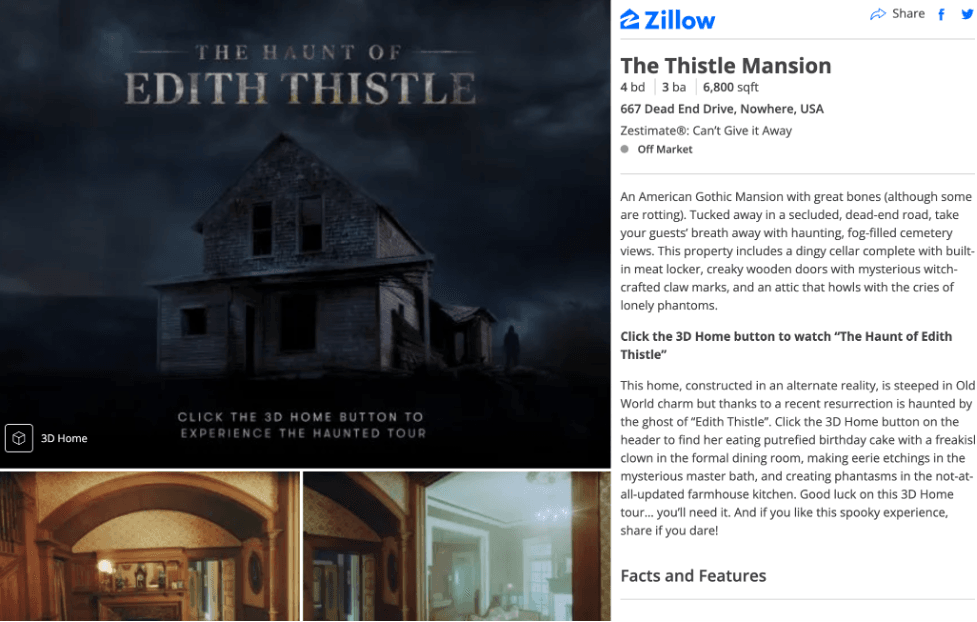
The immersive experience showed off Zillow’s house tour functionality and boosted the brand’s connection with buyers.
In fact, the campaign was so successful that Zillow’s share price jumped by 10%.
Remax TV Campaign:
Remax created a campaign focused on how agents can tailor assistance to different lifestyles.
Each ad showcased scenarios of people connecting in their new homes and working closely with a real estate agent. This helped prospects resonate with (and feel excited about) the idea of moving into a new home themselves.
Remax also tugged on emotion to connect with viewers in a more meaningful way:
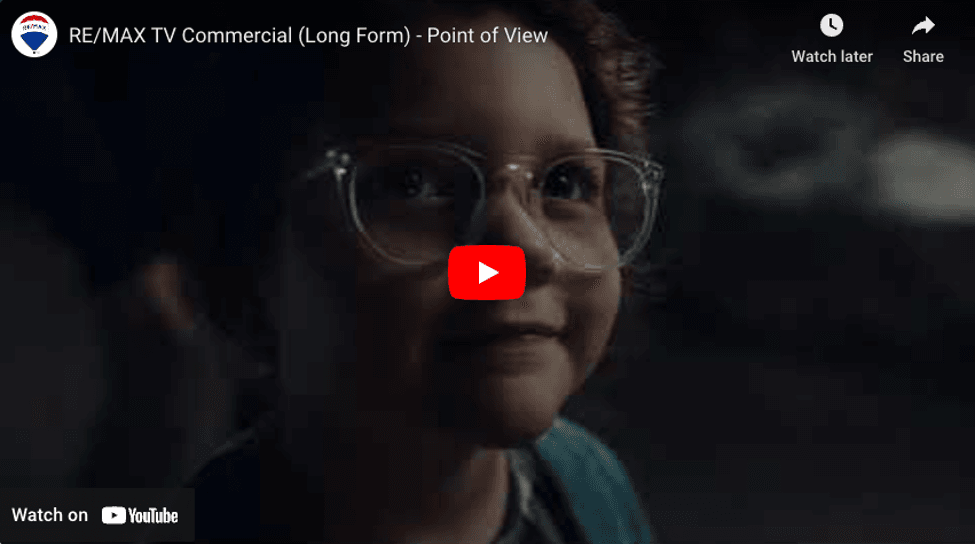
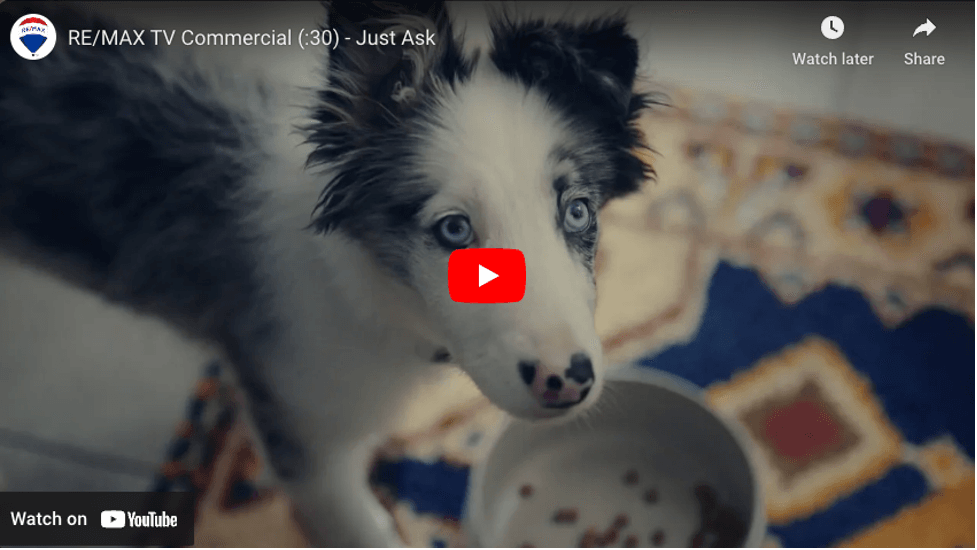
As a result, Remax’s share price increased by 10% in just two weeks, with over 65 million views on YouTube.
These real estate ad campaign examples clearly demonstrate how creatively targeted ads with relatable visuals can significantly impact your real estate business.
How to Set Your Ad Budget
Setting an ad budget is crucial for any real estate ad strategy.
It makes sure you allocate resources efficiently to reach potential homebuyers without overspending.
Here are some factors to consider when setting up your ad budget:
-
Target audience: Who are you trying to reach? Different demographics need different platforms and types of ads.
-
Advertising goals: What are you trying to achieve? For instance, do you want more brand awareness, lead generation, or direct sales?
-
Existing customer behavior: Where do your best customers find you? Figure out which ads and platforms already help to achieve your goal so you can focus your efforts.
But how do you figure out how much money to spend on ads?
Here are the different methods for determining ad spending:
Cost Per Action (CPA)
This includes metrics like Cost Per Click (CPC) and Cost Per Lead (CPL).
With this method, you only pay when a specific action happens, making it pretty cost-effective.
For instance, if your goal is website visits, you only pay when someone clicks on your ad.
Return on Ad Spend (ROAS)
This method measures how much revenue you generate for every dollar spent on advertising.

Pro-Tip: Look for ad opportunities with high ROAS.
For example, Google Ads has an ROAS of 2:1. For every dollar you spend, you generate two.
Customer Acquisition Cost (CAC)
This focuses on the cost of acquiring a new customer.
Work this out by dividing the total ad spend by the number of new customers.
You want a lower CAC for more efficient spending.
Lifetime Value (LTV) or Average Revenue Per Customer (ARPC)
Consider how much revenue a customer generates during their relationship with you.
Maybe they buy one house and never come back. Maybe they switch to a new rental property each year.
Calculate this by multiplying the average customer value by the lifespan to determine how much you can afford to spend on acquiring new customers.
Before
After
Best Real Estate Advertising Methods
The real estate industry moves fast.
To keep up, you need an attention-grabbing advertising strategy that connects with your ideal client and generates high-quality leads.
As we saw in the Remax example above, real estate sales are often an emotional decision.
As MDA Group puts it …
“Emotional ties play a crucial role in both the sales and purchase process.”
Regardless of your platforms or strategies, your ads must drive an emotional connection with your potential clients.
They need to be able to picture themselves at home in your properties. That’s where tools like Virtual Staging AI are invaluable.
With this AI-powered staging app, your bare, empty properties come alive:
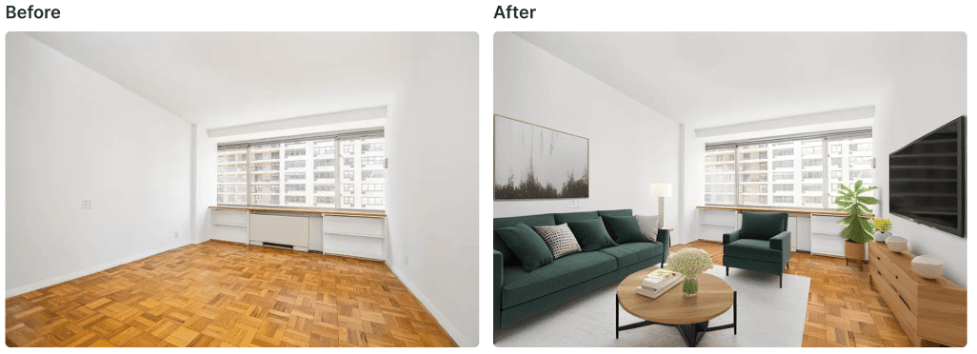
Use it to virtually stage your properties to capture your ideal audience. Remember to consider their ideal style preferences when staging each property. You can run unlimited renders to see which staging options resonate best.
Ready to see it in action? Try Virtual Staging AI for free today.
And now, let’s get to those ad types we promised you.
Meta Ads (Instagram and Facebook)
Facebook and Instagram are popular platforms for advertising real estate.
Instagram is great for brand awareness.
Since Instagram ads are limited in length — either 15 or 60 seconds — they’re less suited to lengthy tours.
These ads are better at quickly showing off what your real estate brand does well.
Create short, engaging content with high-quality visuals that tell a story about your brand.
Add a keyword-rich caption and a simple call-to-action like “View more” or “Learn more.”
Facebook, on the other hand, is better for in-depth engagement.
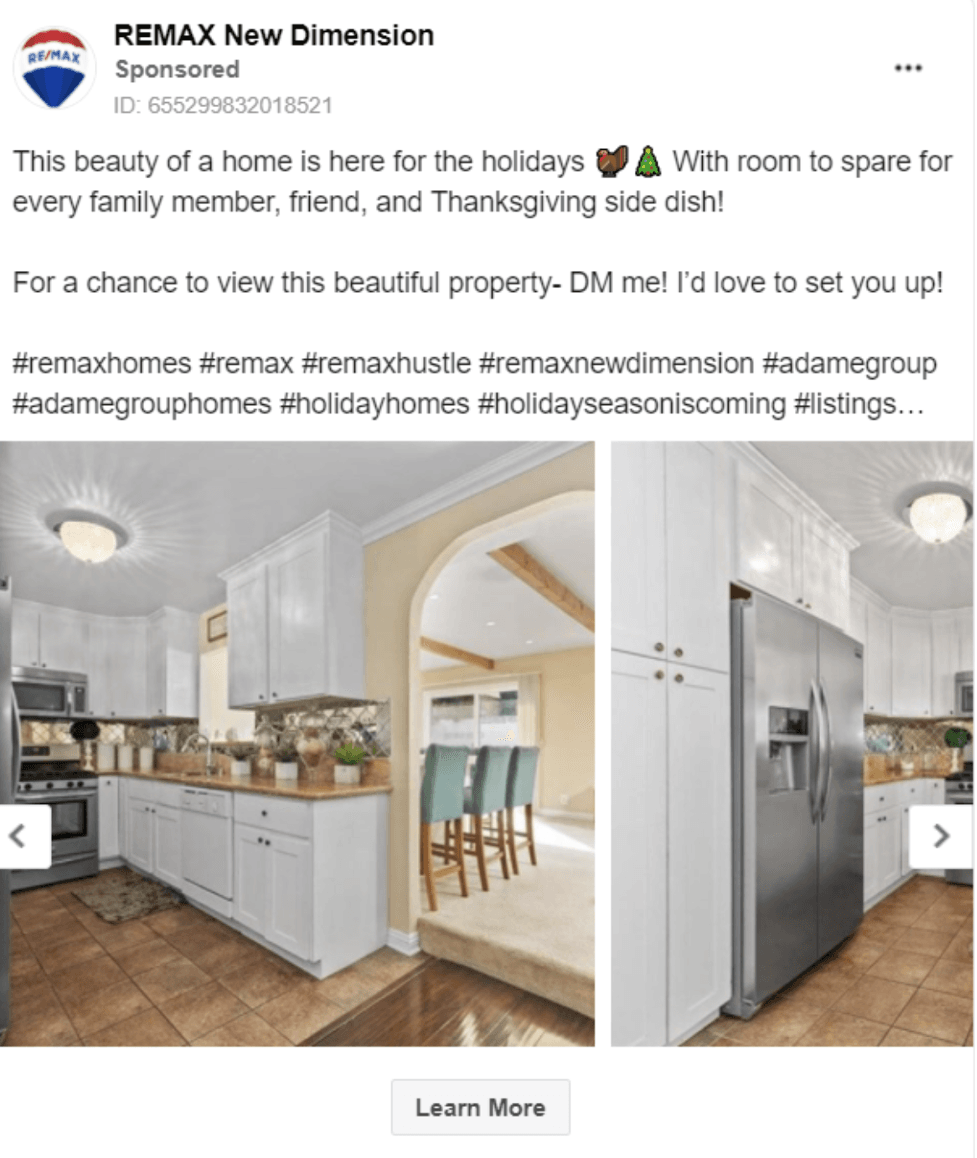
Facebook users are looking to engage and build networks, using groups and long-form comments to interact.
Target these ads based on your ideal client’s lifestyle, hobbies, and interests. This strategy helps them find your ads while engaging with content they’re passionate about.
In case you don’t want to advertise on both platforms, here are the key differences:
-
Target audience: Instagram appeals to younger users, while Facebook is more effective with an older demographic.
-
Content style: Instagram is ideal for concise, visually appealing content. Facebook supports more detailed and long-form content.
-
Interactivity: Instagram focuses on visual engagement, whereas Facebook offers more opportunities for direct engagement and longer discussions.
-
Advertising costs: Instagram generally has higher average costs per click ($0.20-$2.10), but it’s cheaper to reach a wider audience (average CPM (Cost Per Thousand Impressions) - $7.00). On average, Facebook impressions are a little pricier ($7.55), but click costs are lower ($1.00).
LinkedIn Ads
LinkedIn Ads are a powerful tool for commercial real estate marketing.
Remember, LinkedIn users aren’t really house-hunting on the platform. But they’re often decision-makers in businesses looking to expand.
They’re seeking office space, storage, or warehousing solutions — so if you sell commercial properties or space, don’t skip this platform.
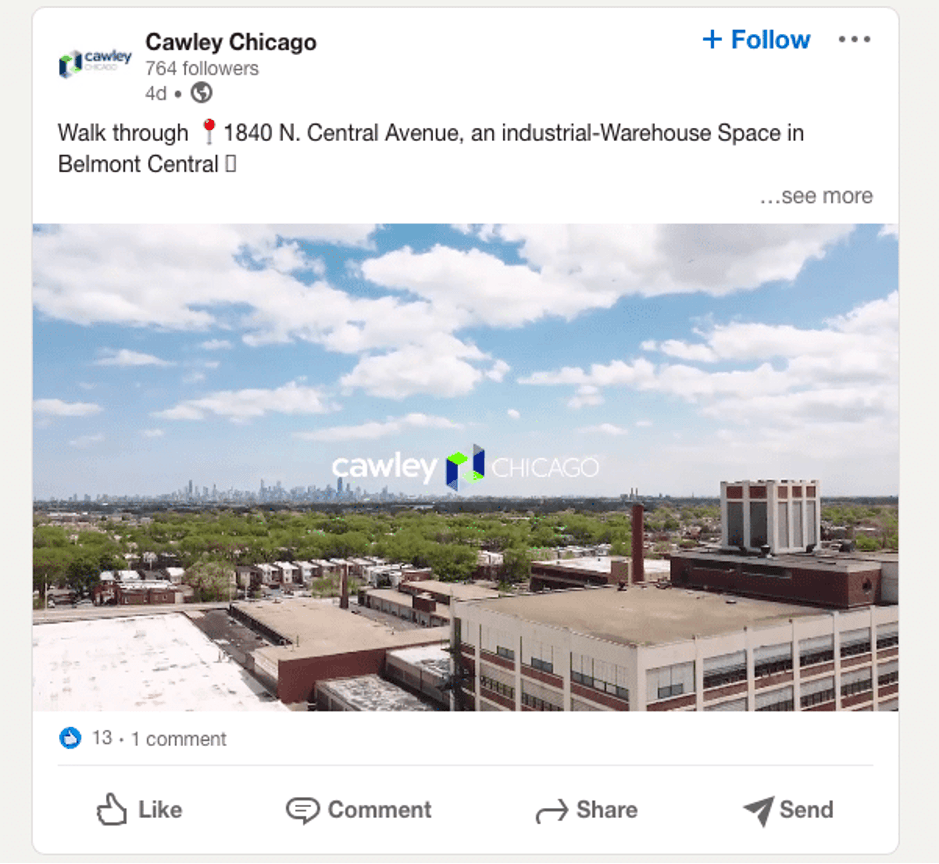
LinkedIn ads are also effective. To get the best from these ads, focus on bottom-of-the-funnel content.
This is the content a potential customer consumes right before they choose to buy.
While the platform’s ads have a click-through rate (CTR) of 0.39%, this figure rises to 0.65% for bottom-of-the-funnel (BOFO) campaigns.
Consider integrating virtual tours, limited-time offers, and satisfied customer case studies into your LinkedIn ads.
Use LinkedIn’s advanced targeting features so your ads appear to your ideal audience.
For effective in-feed ads that resonate with your target market, try the following LinkedIn marketing tips:
-
Use Virtual Staging AI to stage compelling, realistic commercial spaces.
-
Focus on short ad copy that’s straightforward about your benefits.
-
Sprinkle in short and strong CTAs — “Download” and “Learn More’ work best.
-
Integrate client testimonials to endorse your brand.
Google Ads
On average, Google ads return double your ad spend.
Google’s diverse ad platforms offer many ways to reach prospective buyers.
Here are the different types of Google ads available to showcase your real estate business:
-
Search ads: Appear in Google search results. These are ideal for reaching users who are actively searching for real estate listings or firms.
-
Display ads: Appear on websites within the Google Display Network. These work great for building brand awareness among a wider audience.
-
Shopping ads: Shown as property listings in Google Shopping, these ads help you directly target users looking for specific real estate types.
-
Video ads: Appear on YouTube and other video platforms. These are perfect for engaging potential buyers with virtual tours.
-
Discovery ads: Appear on Google’s “Discover” feed. These work well to target users based on their interests and online behavior.
-
Local services ads: Appear in search results for specific area searches. These ads are perfect for local real estate firms.
-
Performance Max ads: Google’s AI optimizes ad performance so your ads appear across all Google platforms, reaching the most appropriate audience in diverse settings.
-
Smart ads: Simplified ads automatically optimized by Google. These ads are ideal if you’re new to online advertising.
Be aware that Google ad costs vary.
Price and placement depend on factors like bidding strategy, ad relevance, and keyword competition.
Use Google’s smart advertising features to optimize these factors and reach the right audience at a cost that best fits your budget.
YouTube Ads
YouTube Ads offer real estate agents a dynamic way to reach audiences.
They’re also quite cheap, with an average CPM of $3.53 and an average CTR of 0.65%.
Here are a few ways to use YouTube’s different ad formats to advertise your real estate firm:
-
Skippable in-stream ads: Skippable ads play before, during, or after other videos — viewers can skip after five seconds. Use these for longer showcases like virtual property tours, agent introductions, and customer testimonials.
-
Non-skippable in-stream ads: These ads can’t be skipped. Since they’re 15–20 seconds long, use them for concise property highlights, promotion announcements, or event introductions.
-
Bumper ads: Just six seconds long, these ads are perfect for quick, memorable messages. Use these to announce an open house or offer a quick tip.
OOH Ads
Out-of-Home (OOH) advertising refers to ads people see while they’re on the go.
These include billboards, transit ads, public digital screens, and posters.
Despite the focus on social media advertising, OOH ads are still the most memorable.
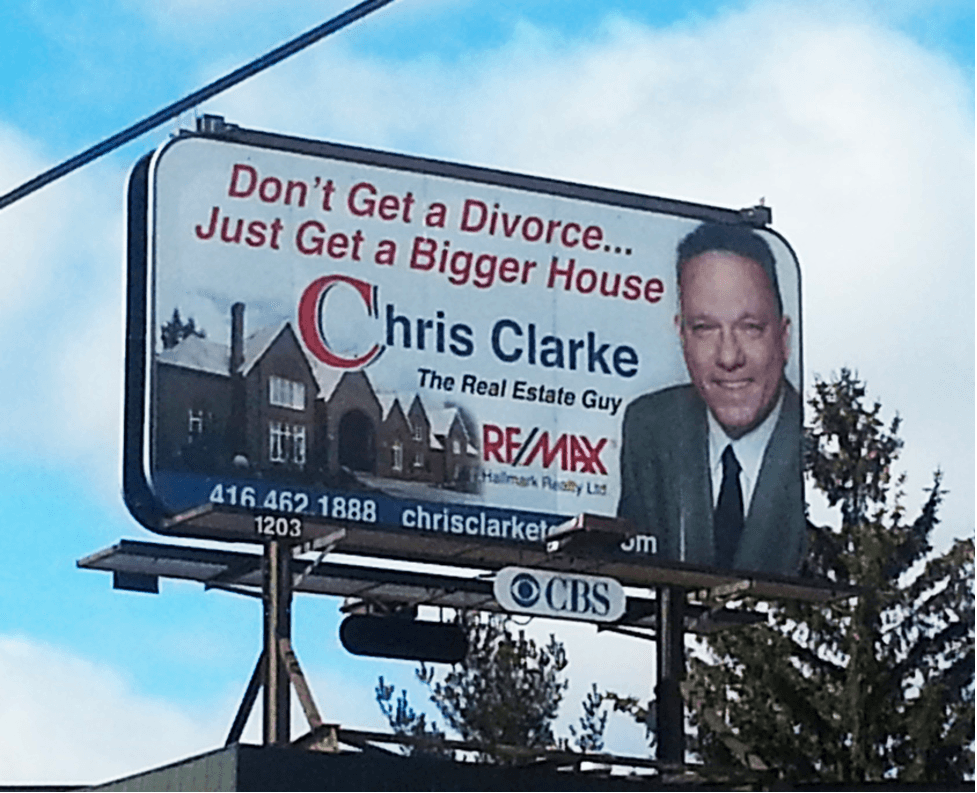
As Anna Bager, President & CEO of OAAA, explains …
“OOH has higher consumer ad recall than other media and drives more consumer action. The bottom line is there is no other medium that offers effectiveness at a better value.”
Additional OOH advertising benefits include:
-
A broad reach, capturing the attention of diverse audiences, including both sellers and buyers
-
Strategic placement in high-traffic areas leads to high visibility, so lots of people see your message.
-
OOH ads are often creative and visually striking, which is why they’re the most memorable form of advertising.
-
Location-specific ad campaigns help real estate firms target local markets.
Remember, OOH ads are all about memorability.
Get creative to capture, entertain, and inform your audience in a way they’ll remember.
Print Ads
Print ads are traditional forms of physical advertising.
You’ll see print ads in newspapers and magazines, as well as direct mailers and flyers.
The key to successful print advertising is the combination of captivating visuals and concise messaging.
Grab the reader’s attention with high-quality property images and compelling copy that encourages them to take action.
Bear in mind the challenges of print ads, though.
Print ads don’t have the highest ROI.
On average, you’ll see a return of around 122%. So, for every ad dollar you spend, you’ll see 22 cents in revenue.
Also, consider the issues with targeting.
While you can select certain publications to reach a particular audience, specific targeting is limited.
To get results with this method, you’ll need to test a variety of publications to see which ones have the best conversion rates.
Before
After
Choosing the Best Advertising Method for You
Diverse advertising helps you reach your audience on different platforms.
But remember, it’s best to work out where your target audience converts best and focus your efforts there.
Always consider the type of content, platform, and message that best resonates with your ideal clients. Monitor and test your ads, and use the insights you uncover to improve your ad strategy going forward.
No matter how and where you advertise, you need to market with emotion. Create a story around your property to sell your customers a lifestyle they crave.
Stage property images with Virtual Staging AI to bring your listings to life. Try it for free today.
Frequently Asked Questions (FAQs)
In case you still have some questions, here are the answers to some of the common FAQs realtors have around marketing and advertising:
How do realtors generate real estate leads?
It’s a mix. Realtors generate leads through networking, online marketing, and advertising.
They might use social media ads, lead-capture landing pages, open houses, and community events to reach out to clients.
What is CRM in real estate?
CRM stands for Customer Relationship Management.
It’s a system that helps you track interactions with clients and prospects. This makes it easier to manage leads and keep track of communication.
Plus, your CRM will organize client information, track sales progress, and automate marketing efforts. It’ll also help you analyze this data for future marketing decisions.
How do I get more leads on Zillow?
To get more leads on Zillow, optimize your listings.
Add high-quality and staged photos, detailed information, and contact information for the next steps.
Actively engage with your leads. Respond to inquiries quickly and encourage past customers to leave reviews.